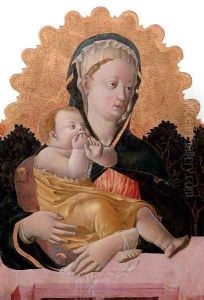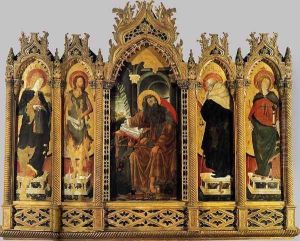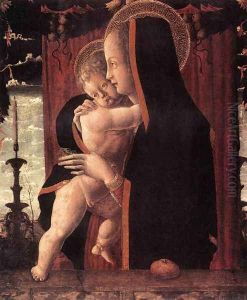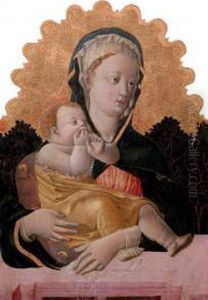Francesco Squarcione Paintings
Francesco Squarcione, born in 1397 in Padua, Italy, was an influential figure in the early Italian Renaissance who significantly contributed to the development of the Paduan school of painting. Though not much is documented about his early life, Squarcione showed an early inclination towards art. He was not only a painter but also a collector of classical artifacts and a teacher, roles that profoundly impacted the artistic landscape of his time.
Squarcione's journey into art began with his fascination for ancient Roman ruins and Greek art, which he encountered during his travels across Italy and perhaps, the Eastern Mediterranean. These experiences deeply influenced his artistic style, characterized by a strong emphasis on antiquity, which he sought to revive in his works. Beyond his own creations, Squarcione's legacy is particularly marked by his founding of a painting atelier in Padua, which became a significant center for artistic training in the 15th century. This workshop attracted numerous young artists from across Italy, eager to learn from the master and from the extensive collection of art and antiquities he had amassed. Among these was Andrea Mantegna, who became his most famous pupil and later, his adopted son. Mantegna's work would go on to reflect the rigorous training and classical influence that were hallmarks of Squarcione's teaching.
Despite his importance as a teacher and mentor to many artists of the Renaissance, there are few surviving works definitively attributed to Squarcione himself. His style is known to have been innovative for its time, incorporating elements from his vast collection of Roman sculptures and artifacts into his paintings. He was particularly adept at using these classical forms to imbue his religious commissions with a sense of gravitas and historical depth, a practice that would become a defining characteristic of the Paduan school.
Squarcione's relationship with his pupils, especially with Mantegna, grew complicated over time, leading to legal disputes that eventually saw Mantegna breaking away to pursue his own artistic path. Despite these personal and professional challenges, Squarcione's influence on the Renaissance art world remained undiminished. His approach to teaching, his incorporation of classical motifs into painting, and his role in establishing Padua as a center of artistic learning paved the way for the next generation of Renaissance artists.
Francesco Squarcione died in 1468, leaving behind a complex legacy. While direct examples of his artwork are scarce, his impact is seen in the works of his pupils and in the continued reverence for classical antiquity that characterized much of Renaissance art. Today, Squarcione is remembered not just for the paintings that may or may not have been his own, but for his vision of integrating classical heritage with contemporary artistic practice, a vision that helped shape the course of Italian Renaissance art.



